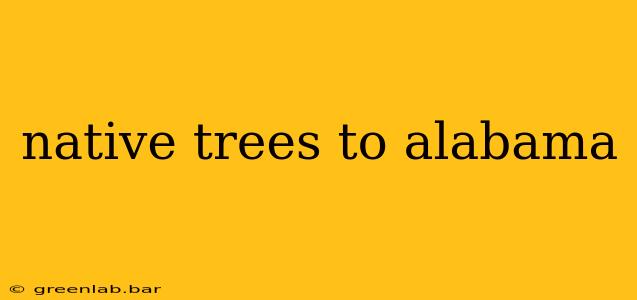Alabama boasts a rich biodiversity, and its native trees are a significant part of its natural beauty and ecological balance. From the majestic Southern Live Oak to the vibrant Red Maple, the state's diverse habitats support a wide array of species. This guide explores some of Alabama's most iconic and ecologically important native trees, providing valuable insights for both seasoned gardeners and nature enthusiasts.
Understanding Alabama's Diverse Tree Habitats
Alabama's varied topography, encompassing coastal plains, Piedmont uplands, and Appalachian foothills, creates a mosaic of habitats, each supporting its unique tree communities. Understanding these variations is crucial for selecting the right trees for your landscape or appreciating the ecological roles they play in the wild.
-
Coastal Plain: This region, characterized by flatlands and sandy soils, features trees adapted to moisture fluctuations and sometimes saline conditions. Species like the Bald Cypress and Water Oak thrive here.
-
Piedmont: The Piedmont's rolling hills and richer soils support a wider variety of trees, including Red Maple, White Oak, and various Hickory species.
-
Appalachian Foothills: The higher elevations and cooler temperatures of the Appalachian foothills provide habitat for species such as Yellow Poplar and certain Oak varieties that prefer more temperate conditions.
Showstopper Native Trees of Alabama: A Closer Look
Several native Alabama trees stand out for their beauty, ecological importance, and adaptability to various landscapes. Let's delve into some notable examples:
1. Southern Live Oak ( Quercus virginiana)
The majestic Southern Live Oak is arguably Alabama's most iconic tree. Its sprawling, wide-spreading branches, often draped with Spanish moss, create a breathtaking sight. This long-lived tree thrives in various conditions, making it a popular choice for landscaping. Its acorns are a crucial food source for wildlife.
2. Bald Cypress (Taxodium distichum)
The Bald Cypress is a remarkable conifer adapted to wet conditions. Found in swamps and along waterways, it's easily recognized by its "knees"—unique root structures that protrude from the water. These trees provide critical habitat for diverse wildlife.
3. Red Maple (Acer rubrum)
A vibrant addition to any landscape, the Red Maple displays stunning fall foliage, turning shades of scarlet and crimson. Its adaptability to various soil types makes it a widely distributed and ecologically significant species in Alabama.
4. White Oak (Quercus alba)
The White Oak is a stately tree known for its strong wood and longevity. Its acorns are an essential food source for many animals, including squirrels and deer. Its hardiness and beauty make it a prized addition to any landscape.
5. Yellow Poplar (Liriodendron tulipifera)
Also known as the Tulip Poplar, this impressive tree can reach towering heights. Its distinctive tulip-shaped flowers and large leaves make it a striking addition to larger properties. This fast-growing tree is also valuable for its timber.
Choosing Native Trees for Your Alabama Landscape
When selecting native trees for your landscape, consider the following factors:
- Site Conditions: Assess your soil type, sunlight exposure, and moisture levels.
- Mature Size: Choose trees whose mature size is appropriate for your space.
- Wildlife Value: Consider the trees' ability to provide food and shelter for birds and other wildlife.
- Aesthetic Appeal: Select trees with foliage and flower characteristics that complement your personal preferences and landscape design.
By thoughtfully selecting and planting native Alabama trees, you contribute to the preservation of the state's rich biodiversity and create a beautiful, thriving landscape. Remember to consult with local nurseries and arborists for advice tailored to your specific region and site conditions. Enjoy the natural beauty and ecological benefits that Alabama's native trees offer!

